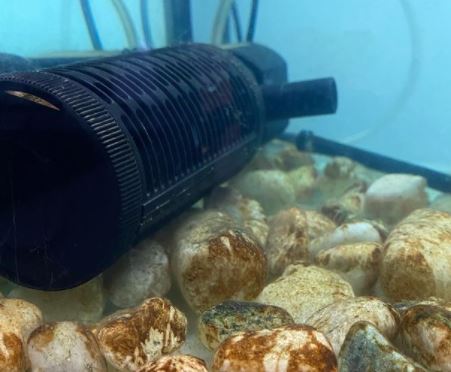“Why is my turtle tank filter so loud?”
That is a question that usually comes up when the person owning the tank is experiencing trouble sleeping or relaxing because of how loud it can be.
The noise may also be bothering others in the household, which leads to conflict and arguments over who should do something about it.
Turtle filters are designed with a variety of different levels of water movement for multiple sizes and shapes of tanks.
Some people purchase one that is too powerful for their space, thus creating more noise than necessary.
It’s important to know what size your tank is before ordering a filter so you don’t have this problem!
Read on to know the answer to the question, “Why is my turtle tank filter so loud?”
Related Posts:
- Top 5 Turtle Substrate for Your Pet Tank
- Can I Keep My Turtle Tank Outside?
- Can You Put Sand in Your Turtle Tank?
- How Much Does a Turtle Tank Filter Cost?
Why Is My Turtle Tank Filter So Loud?
So, why is your turtle tank filter so loud?
This is mostly made of dirt and other stuff. If this is not cleaned, it can result in a filter pump that does not work. So, a good cleaning should help to reduce this noise.
But if the filter part breaks, the sound will be louder and different than humming or buzzing sounds because it will be more rattling or shaking sounds.
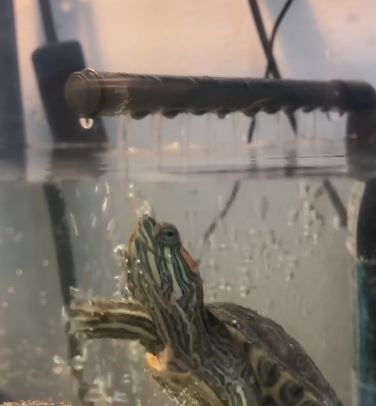
How to Get Rid of the Noise in an Aquarium?
It’s time to get rid of the noise in your aquarium. Thanks to our modern technologies, we can build a filter system that produces nothing but silent bliss for you and your fishy friends. Here is how to get rid of it.
1. Get an Eheim Professional II External Canister Filter
First off, go down to your local pet shop and pick up an Eheim Professional II external Canister Filter (size 2000). This is an excellent filter capable of filtering up to 200 gallons per hour! It has 6 trays where you can put different kinds of media.
I’ve used it for over 5 years now with no problems whatsoever. The only downside is that it’s not very aesthetically pleasing (this is why there are no pictures below). You also need to use Eheim brand replacement parts.
It will set you back about $150. But if you think about the money and time you will save on filters in the long run, it’s worth it. Plus, Eheim is a respected company that has been around for over 60 years! They know what they’re doing!
2. Buy a Clear Acrylic Plastic
Now, go down to your local Home Depot and buy a 12″x12″ sheet of 4mm thick clear acrylic plastic. You should be able to get this for less than $100.
Make sure it’s at least 1cm larger than your filter all around (front, back, and sides). This will allow for proper installation.
If you have an old filter lying around that you can use as support towards the rear of the new acrylic tank, even better!
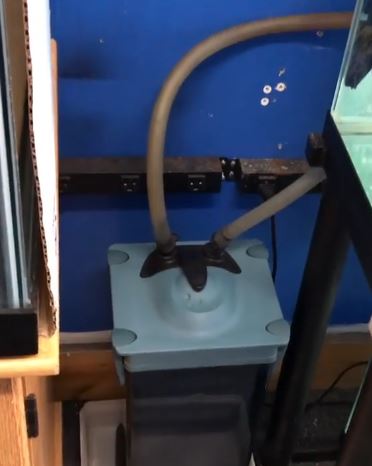
3. Cut Out a Hole on One Side of Your Aquarium
Most canister filters consist of a cylindrical tube with a round bottom and a flat top. The water is sucked through the intake tube at the bottom, passed through the filter media, and then flows out freely from an opening on top (see picture below).
All you have to do is cut out a hole of the same diameter as the intake tube of your old filter on one side of your new aquarium. You don’t need to worry about aesthetics here since nobody will see it anyways.
Make sure you plan everything before you mark and drill holes for this part. Once it’s done, you won’t be able to undo it! I suggest making a template with paper or cardboard so that you get your hole exactly in the middle of your new tank.
4. Plug the Canister Filter Into the Hole
Now that you have everything ready, all you have to do is simply plug your canister filter into the newly created hole and fasten it with screws.
Use large enough screws so that they don’t go through your acrylic! The whole thing should be quite sturdy now.
Make sure, however, that there’s always a drip loop on the intake tube. This will prevent an accident where water spills everywhere if someone decides to yank on it too hard (I only speak from experience here).
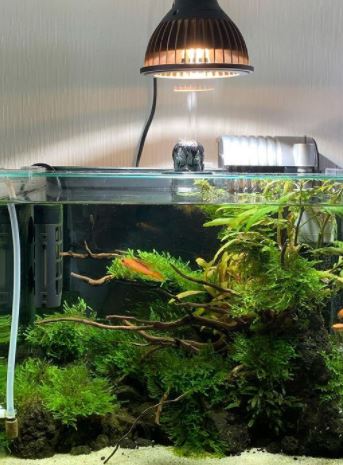
5. Put Some Substrate
Finally, put some substrate that will act as a fissure between your main tank and the new filter. I simply used aquarium gravel.
This will prevent a disaster if something happens to your new filter and you have to shut it off. Since the water is being pumped into the top of the setup, make sure the fissure is not too large. I used about 3″ of gravel.
Typically, this is enough for most setups up to 100 gallons or so. If you need more filtration for larger tanks, you can easily add another one of these filters on top of this one by drilling a hole in your overflow tank.
However, do not plug the tubing leading from this overflow tank into an intake of your main canister!
Instead, leave them free-flowing towards a bucket that you will pour back into your aquarium once a day (I know some advanced aquarists who have successfully used the tubing coming out of their overflow to pump water back into the tank)
Why Is My Fish Tank Pump Making a Weird Noise?
There are many reasons why your aquarium fish tank pump may be making a weird noise. Here is a quick list of the common ones:
- The impeller is out of balance. This can happen if you have debris in your pump, or if something has fallen into it and is hitting the propeller blades. In this case, most likely, you will see a bent blade, too.
- There’s air trapped in the line. Unhook any tubing from your pump and drain it until no more bubbles come out when the pump stops running. Then hook it back up.
- The impeller is hitting something inside the pump housing. Turn it off and check carefully for anything that may be stuck under or inside where the impeller goes.
- The water level in your tank is too low to allow the pump to run properly. A powerhead with an intake tube needs at least two inches of water above the intake to work well. Otherwise, it has nothing to suck against and will “chug” or become unbalanced easily. Make sure your return lines are high enough in the tank if you have a deep sump filter installed on your system, too! They also need two inches of water over them as well.
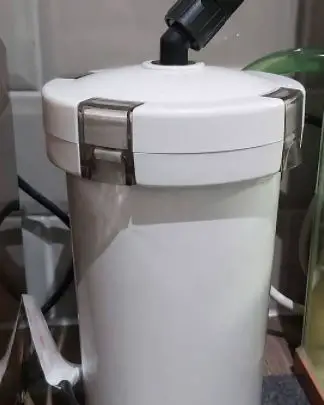
- You may have some air bubbles still coming out of the tubing even after you have bled them out. If this is the case, submerge the pump underwater for about ten minutes so any air bubble caught in the impeller will dissipate. Then turn it on and see if the problem goes away.
- It’s possible that your intake screen has become clogged with debris like leaves or algae that are preventing good flow into your pump. Cleaning your pump filter regularly will solve this issue if it happens frequently.
- The propeller itself may be bent (rare) but this would require a pretty serious impact to make happen, like dropping something really heavy onto it!
- Sometimes, electrical surges can cause weird noises to come from your equipment. If your pump is far away from the tank it’s plugged into, you may have a voltage issue as well as a grounding one. Make sure all of your electrical wires are hooked up properly and that they run to a GFCI outlet!
- Your impeller may be worn out or failing. Look at your pump closely. If the blades on the impeller look stripped or shredded apart, it’s probably time for a new one! Make sure you purchase a replacement kit with your new impeller so you can easily install it.
- No matter what kind of noise your fish tank pump is making right now, please remember that sound can travel through the water much easier than through the air. This means you may not hear your fish tank equipment running in a different room or even if you’re outside the house! Make sure you check noise levels when buying new equipment for placement, and buy quiet replacement parts if possible.
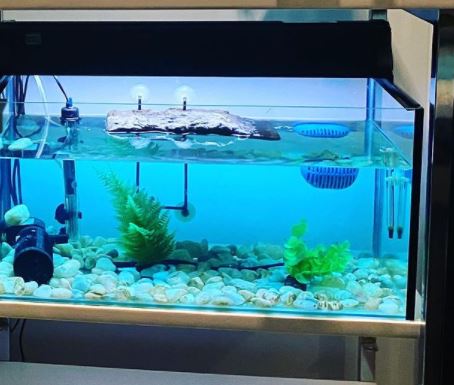
Why Is My Tetra Whisper Filter So Loud?
Tetra Whisper filters are one of the quietest filters on the market. However, if you have your tank in a bedroom or other area where there are people present, noise may be an issue.
It is not uncommon for some customers to move their filter into another room so that it does not disturb them at night when they are trying to sleep.
Different brands of filtration systems produce different levels of noise.
Many canisters or hang-on-back style filters are much louder than submersible ones like the Tetra Whisper.
Another thing you can do is purchase high-quality foam inserts (like Fluval’s), which will reduce the water flow inside the filter and therefore make it less noisy. Quieter operation is one of the factors that make Tetra Whisper filters so popular.
Tetra Whisper aquarium filter is very efficient when it comes to removing solid waste from the water, yet it is designed in a way that causes minimum noise generation while being used. This means that its filtration capacity doesn’t have any impact on the noise level of the unit itself.
If your filter is noisy, there are several things you can do to reduce or eliminate this problem:
- Reduce the flow rate in your tank by using an in-tank adjustment valve. Adjusting valves are usually available where fish supplies are sold (local pet stores) and they can be installed easily without tools, reducing water flow into the filter dramatically.
- Purchase foam inserts (like Fluval’s), which are made specifically for the Tetra Whisper hang-on models. These will reduce water flow into the filter allowing it to run much quieter.
- When using a submersible model, be sure that your unit is sitting level in your aquarium. If you have it propped up on anything or if one side of the sponge pad is higher than another, this can cause an aeration problem inside the filter housing. This creates turbulence and increases noise levels.
- Some customers find it helpful to place their tank away from main traffic areas, usually behind a cabinet or chair. This allows you to use lower-speed pumps without disturbing others around your home.
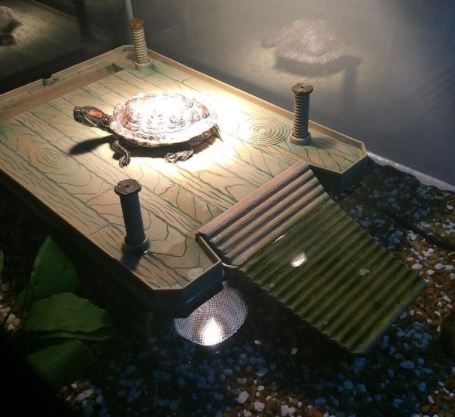
Conclusion
Why is your turtle tank filter so loud?
If you are experiencing unusual noise coming from your turtle tank filter, there may be an issue with the pump impeller. The sound is typically due to a buildup of dirt and debris that can significantly reduce water flow or restrict air intake.
To fix this problem, remove all filters in the filtration system and clean them thoroughly using either dish soap or vinegar-water solution (1 tablespoon per gallon).
After letting it soak for 10 minutes, rinse off each filter with warm tap water then replace back into its original position in the filtration system. Your turtle tank should now operate smoothly without any noticeable sounds!
Further Reading:
- 7 Best Plants for Turtle Tank
- 5 Best Turtle Basking Platforms
- Why Does My Turtle Tank Have White Bubbles?
- How to Keep Turtle Aquarium From Smelling?

